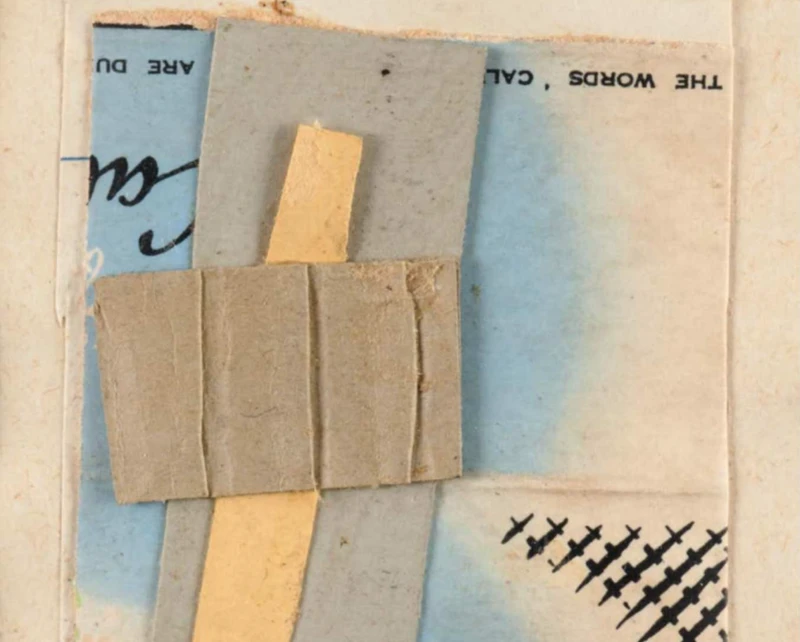Derek Hyatt & Kurt Schwitters: Emissaries Of The Land
3 Nov 2023-16 Feb 2024


This exhibition will offer the rare opportunity to see together a group of Kurt Schwitters’ collages, constructions and paintings made during the last years of his life in Ambleside kindly loaned from the family of Edith "Wantee" Thomas and seen together for the first time in London. They will be shown alongside paintings by the Yorkshire landscape artist Derek Hyatt (1931-2015) in an exhibition that follows a trail leading back to the Kurt Schwitters exhibition held at the Lord’s Gallery, London in 1958.
Kurt Schwitters, born in Germany in 1887, was a painter, a poet, and, most famously, a collagist of found objects rescued from the detritus of his surroundings. He died in 1948 in obscurity in the Lake District but would come to be seen as amongst the most inventive visual and literary artists of the 20th century and a major influence on a young post-modern, Pop-Art scene that emerged during the 50s and 60s in the USA and the UK.
Derek Hyatt had visited the exhibition at the Lord’s Gallery when he was a student at the Royal College of Art and as editor of ARK, the Journal of the Royal College of Art, he had included an article written by himself. Entitled ‘Kurt Schwitters, Paul Nash and Mrs. Nevelson’ it set out his thoughts on the visual similarity he had perceived between the abstract works of Schwitters and the landscape paintings of Nash. Hyatt later wrote:
'The more we know about Schwitters today – his work in the Lake District, Merzbau, etc – the more we realize that he was interested in how landscape imagery could be related to collage, which is usually thought of as an urban medium… I felt Schwitters held an important key, even from the first viewing.’1
These insights offer a clue to Hyatt’s intuitive feeling that the work Schwitters had produced in the rural setting of the Lake District during the late 1940s was the key to a new and exciting approach to the characteristically English pursuit of landscape painting; a view very different to the more popular, consumerist interpretations being shown by his Pop peers. ‘He’s not making crazy juxtapositions. He’s not after wit. He’s after calm affection, visual, formal poetry again and again.’ 2 Hyatt’s own work, though unmistakably linked to the moorland landscape takes the collagist approach and places separate, distinct things close together and allows their proximity to spark connections; juxtapositions that explore relationships between mankind and nature, between the modern world and deep history, between the cycles of the seasons and ultimately civilization itself. And his notebooks too are crammed with observations and ideas: the passage of an owl flying over a snow-covered landscape, of the meaning of a ladybird carved into Hanging Stone Rock by Bronze age dwellers, of local folklore, field patterns, dry-stone walls and cloud formations and the constantly changing light.
Schwitters was one of many artists, writers and poets that were important to Hyatt and he studied, lectured and wrote for Peter Fuller’s Modern Painters on Ruskin, Turner and his friends Victor Pasmore and Peter Lanyon amongst others. But when Hyatt first encountered Schwitters’ work very little had been published about him and he was not to know the influence Schwitters would have on such a range of artists and art movements, literature, film, radio, advertising, typography and many other areas of creative expression since the end of the Second World. This exhibition offers a glimpse into what Hyatt must have experienced in 1958 and his prescience in recognizing a new language that offered ways forward in his quest for a visual language appropriate to a twentiethcentury landscape painter.
Derek Hyatt studied at the Royal College of Art (1954- 58) winning numerous prizes and editing 3 issues of ARK. Along with being a regular contributor in Peter Fuller’s Modern Painters he was elected Companion of the Guild of St George (1990) and has work in major public and private collections worldwide including Yale University, Harvard University and the Museum of Modern Art, New York. He had four solo exhibitions with Art Space Gallery who continue to represent the Estate.
********
1 Burning the Book of Beautiful Things, Alex Seago, ISBN 978-0198174059. Clarendon Press, p. 103
2 Stone Fires – Liquid Clouds, The Shamanic Art of Derek Hyatt, Gothic Images Publications, ISBN 0 906362 59 8, p. 22